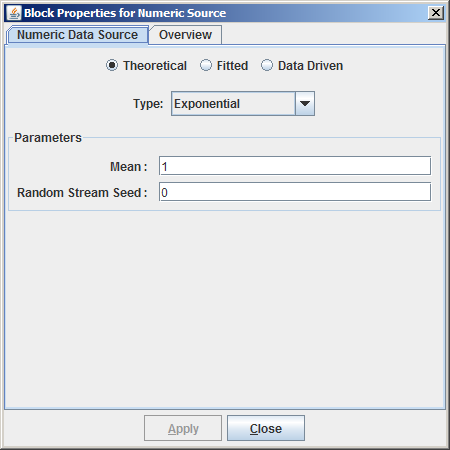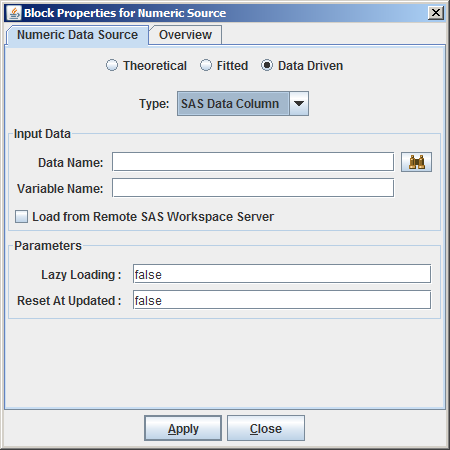Random Variation in a Model
Random and exogenous sources of variation play a central role in discrete- event simulation. Blocks such as the Entity Generator, Value Generator, Server, and Delay blocks usually require a connection to a source of variation. The principal source of variation is the Numeric Source block. The functionality of the Numeric Source block is described in Appendix A: Templates, but this section also provides a quick overview.
The Numeric Source block provides an OutValue output port to which other blocks can connect to pull numeric values. The values produced by this block are dependent on their parameter settings. Figure B.1 shows the Block Properties dialog box for a Numeric Source block with the default settings. The Theoretical option is selected and the Type list box provides a list of the statistical distributions available in Simulation Studio for sampling purposes. You select a distribution from the Type list and then supply the desired parameters in the approripate fields for the distribution that you have chosen. (The details about the distributions available in Simulation Studio are presented later in this appendix.) When a request for a sample comes into the Numeric Source block, the block generates a value based on its parameter settings.
In the Numeric Source Block Properties dialog box, the Fitted option enables you to specify the location of a data set. Then JMP is used to automatically fit a theoretical distribution to the data. The Type and Parameters fields of the Block Properties for Numeric Source dialog box are populated with the appropriate information from the JMP distribution-fitting tool. As indicated in the distribution descriptions in this appendix, some of the distributions available in Simulation Studio are not available in the JMP distribution-fitting tool. For more information about the Fitted option, see Appendix D: Input Analysis.
The Data Driven option in the Numeric Source block properties has a Type list box that provides you with a variety of methods for generating samples that are based on a specific data set. For example, the Discrete Empirical and the Empirical options are especially useful when it is not possible to find a theoretical distribution that fits the data accurately. Furthermore, the nonhomogeneous Poisson process options NHPP Count and the NHPP Rate allow you to generate a time dependent arrival process that is based on either count or rate data. Finally, the SAS Data Column option can be used to read values from a SAS data set or a JMP data table that are then used directly as a source of input to a simulation model. When using this option in the Numeric Source block, you must supply the file pathname along with the column or variable name in the data set. (See Figure B.2.) Simulation Studio uses the filename extension to determine whether the file is a SAS data set or JMP data table. If a filename extension is not specified, Simulation Studio assumes the file is of the type (SAS data set or JMP table) specified in the Default Data Format section of the SAS Simulation Configuration dialog box.

